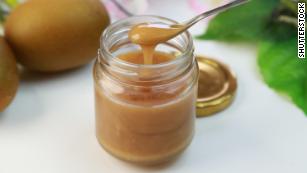Honey is low in water high in sugar ,so bacteria can not grow on it .It also contains small amounts of hydrogen peroxide inhibiting the growth of microbes.
Move over, prehistoric bears. Humans have loved honey since the Stone Age.
Move over, prehistoric bears. Humans have loved honey since the Stone Age.
Rock art pictures of honey harvesting, which at first glance look like drawings from A.A. Milne's Winnie-the-Pooh, date to about 8000 B.C.
Beeswax has been found on pottery dating as far back as 7000 B.C., most likely used for waterproofing. The ancient Egyptians offered honey to the gods and then joined the Greeks, Romans and Chinese in using it as a salve for wounds and a treatment for fevers and stomach ailments.
Today, proponents of honey tout its miraculous healing properties, claiming that it can prevent cancer and heart disease, reduce ulcers, ease digestive problems, regulate blood sugar, soothe coughs and sore throats, and increase athletic performance.
But just how many of these uses, ancient or modern, have been proved by science?
Thumbs up: Antibacterial properties
There's no doubt honey has the power to kill bacteria. Studies have shown that it is effective against dozens of strains, including E. coli and salmonella. A specific type of honey from New Zealand, called manuka honey, along with Malaysian Tualang honey, has been shown to fight staph and the digestive bacteria responsible for peptic ulcers, H. pylori.
What makes honey antimicrobic? Most bees deposit hydrogen peroxide into the honey as they synthesize flower pollen. Add that honey is naturally acidic, and you have a recipe for antibacterial properties.
That would explain honey's centuries-old role in speeding wound healing and treating gastric complaints. Sure enough, modern science has shown honey's effectiveness in treatment of ulcers, bed sores, burns, skin sores and inflammation. Honey has even been known to heal wounds that don't respond to antibiotics, although care must be taken to be sure the honey itself is free of contaminants.
Science has also found that darker, more concentrated honey may be more potent and that the type of plants harvested by the busy bee affects the antibacterial qualities. Although manuka and Tualang honeys have been thoroughly researched, scientists are busy looking at the properties of locally grown honey to understand its potential benefits.
Thumbs up: Soothing throats
A study of 139 children found that honey did a better job of easing nighttime coughs and improving sleep than both the popular cough suppressant dextromethorphan and the antihistamine diphenhydramine (Benadryl).
Another study of 105 children showed that buckwheat honey also outperformed dextromethorphan in suppressing coughs at night. Studies in Italy, using wildflower honey, and Israel, using eucalyptus, citrus and labiatae honeys, found that the gooey stuff outperformed placebos in reducing both nighttime coughs and sleeping troubles in children with respiratory infections.
But be very careful. Honey should never be given to children under the age of 1, because the digestive systems of infants can't handle any contaminates in honey, such as spores that cause botulism. Infant botulism is the most frequent form of human botulism in the US.
Thumbs up? Athletic performance
Three studies done at the sport nutrition lab at the University of Memphis found that honey was just as good or better than glucose, or sugar, water in boosting the staying power of endurance athletes. However, the studies were funded by the National Honey Board, an "industry-funded agriculture promotion group," so more research by impartial scientists is needed.
Jury's out: Cancer, heart disease, diabetes
Studies of diabetic rats have found Tualang honey to play a role in regulating blood glucose. But rats aren't people, and experts warn against using too much of the sweet stuff. Honey is still metabolized as a sugar, just like table sugar, molasses, and maple syrup.
In the lab, Tualang honey has been shown to disrupt breast, cervical and skin cancer cells, but a Petri dish is a long way from a human trial. Still, honey holds promise as an anti-cancer agent and a preventative for heart disease because it contains high levels of antioxidants that fight oxidative stress and inflammation, which underlie many cancers and cardiovascular disease.
So, think of honey as you would blueberries, broccoli and other cruciferous veggies, nuts, grapes, dark green veggies, tea and whole grains: Eating a mix of healthy powerhouse foods can only help your body fight disease.
Referenece Material :http://www.cnn.com/2018/01/15/health/honey-health-benefits/index.html
Referenece Material :http://www.cnn.com/2018/01/15/health/honey-health-benefits/index.html



टिप्पणियाँ
एक टिप्पणी भेजें